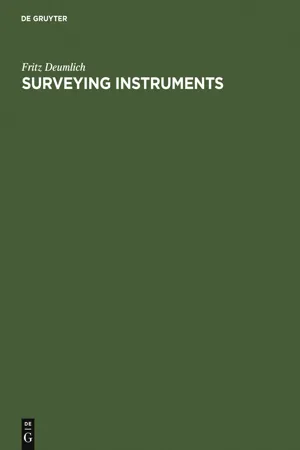
This is a test
- 316 pages
- English
- PDF
- Available on iOS & Android
eBook - PDF
Surveying Instruments
Book details
Table of contents
Citations
About This Book
No detailed description available for "Surveying Instruments".
Frequently asked questions
At the moment all of our mobile-responsive ePub books are available to download via the app. Most of our PDFs are also available to download and we're working on making the final remaining ones downloadable now. Learn more here.
Both plans give you full access to the library and all of Perlego’s features. The only differences are the price and subscription period: With the annual plan you’ll save around 30% compared to 12 months on the monthly plan.
We are an online textbook subscription service, where you can get access to an entire online library for less than the price of a single book per month. With over 1 million books across 1000+ topics, we’ve got you covered! Learn more here.
Look out for the read-aloud symbol on your next book to see if you can listen to it. The read-aloud tool reads text aloud for you, highlighting the text as it is being read. You can pause it, speed it up and slow it down. Learn more here.
Yes, you can access Surveying Instruments by Fritz Deumlich, Wolfgang Faig in PDF and/or ePUB format, as well as other popular books in Physical Sciences & Geology & Earth Sciences. We have over one million books available in our catalogue for you to explore.
Information
Table of contents
- Introduction
- I. Purpose and Classification of Surveying Instruments
- II. History of Surveying Instruments
- III. Manufacturers of Surveying Instruments
- IV. Standardization
- V. Further Developments
- VI. Operation and Care of Surveying Instruments
- 1. Optical Equipment and Level Bubbles
- 1.1. Optical Equipment
- 1.1.1. Fundamentals of Optics
- 1.1.2. Optical Instruments
- 1.2. Spirit Levels
- 1.2.1. Tubular Levels
- 1.2.2. Bull’s Eye Levels
- 1.2.3. Electronic Levels
- 1.2.4. Tilt Compensator
- 2. Instruments for the Determination of Horizontal Projections of Points
- 2.1. Instruments for Staking Right and Straight Angles
- 2.1.1. Diopter Instruments
- 2.1.2. Mirror Instruments
- 2.1.3. Prism Instruments
- 2.2. Simple Instruments to Measure and Stake Horizontal Angles
- 2.2.1. Goniasmometer
- 2.2.2. Stock Compass
- 2.3. The Theodolite
- 2.3.1. Tripod and Support of the Theodolite
- 2.3.2. Structure of the Theodolite
- 2.3.3. Overview of Different Theodolite Types
- 2.3.4. Testing and Adjusting of Theodolites
- 2.4. Gyro Instruments
- 2.4.1. Fundamentals of Gyro Instruments
- 2.4.2. Structure of the Surveying Gyro
- 2.4.3. Overview of Surveying Gyros
- 2.4.4. Measurements with Surveying Gyros
- 2.5. Optical Precision Plummets
- 2.6. Alignment Instruments
- 3. Instruments to Measure Elevations and Elevation Differences
- 3.1. Simple Instruments for Geometric Levelling
- 3.1.1. Hydrostatic Levels
- 3.1.2. Pendulum Instruments
- 3.1.3. Handheld Levels
- 3.1.4. Horizontal Straight Edge
- 3.2. Levels
- 3.2.1. Tripod and Fastening Devices for Levels
- 3.2.2. Structure of the Level
- 3.2.3. Overview of Different Types of Levels
- 3.2.4. Testing and Adjusting of Levels
- 3.2.5. Level with Inclined Line of Sight
- 3.2.6. Levelling Rods
- 3.3. Instruments to Measure Vertical Angles
- 3.3.1. Simple Instruments to Measure Vertical Angles
- 3.3.2. The Use of the Theodolite for Vertical Angle Measurements
- 3.3.3. Sextant
- 3.4. Instruments for Barometric Levelling
- 3.4.1. Mercury Barometer (Hg-Barometer)
- 3.4.2. Aneroid Barometers
- 3.4.3. Hypsometers
- 3.5. Fully Automatic Elevation Measuring Devices
- 4. Instruments for Distance Measurement
- 4.1. Instruments for Direct (Mechanical) Distance Measurements
- 4.1.1. Simple Means for Distance Measurements
- 4.1.2. Auxiliary Devices for Distance Measuring Instruments
- 4.1.3. Measuring Rods
- 4.1.4. Measuring Tape
- 4.1.5. Baseline Measuring Apparatus with Invar Wires or -Tapes
- 4.2. Instruments and Devices for Optical Distance Measurements
- 4.2.1. Distance Meters with Base at the Target
- 4.2.2. Distance Meters with Base at the Station
- 4.3. Instruments for Electronic Distance Measurements
- 4.3.1. Principle of Electronic Distance Measurements
- 4.3.2. Instruments for Distance Measurements with the Impulse Method
- 4.3.3. Instruments for Distance Measurements with Phase Comparison
- 4.3.4. Interference Comparator
- 5. Tacheometric Instruments
- 5.1. Non Reducing Tacheometers
- 5.1.1. Stadia Theodolites
- 5.1.2. Stadia Compasses
- 5.1.3. Stadia Levels
- 5.1.4. Tacheometers with Base at the Station
- 5.2. Self Reducing Tacheometers
- 5.2.1. Slide Tacheometers
- 5.2.2. Tacheometers Based on the Tangent Principle
- 5.2.3. Diagram Tacheometers
- 5.2.4. Tacheometers with Mechanically Monitored Variable Line Separation
- 5.2.5. Reduction Tacheometers with Double Image Distance Meter
- 5.2.6. Self Reducing Tacheometers with Base at the Station
- 5.2.7. Auxiliary Instruments for Automatic Reduction
- 5.3. Electronic Tacheometers
- 5.4. Plane Table and Alidade
- 5.4.1. Plane Table Equipment
- 5.4.2. Overview of Plane Table Equipment
- 5.4.3. Testing and Adjusting of Plane Table Equipment
- 5.4.4. Topographic Rods
- References
- Index